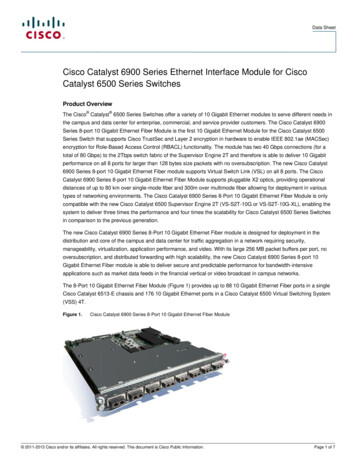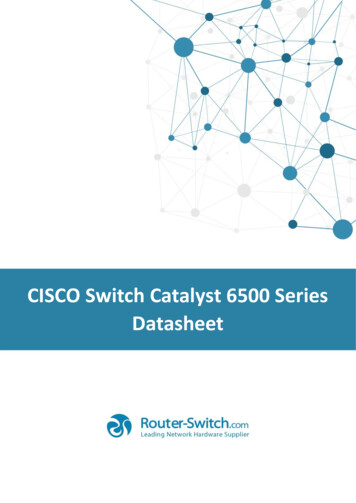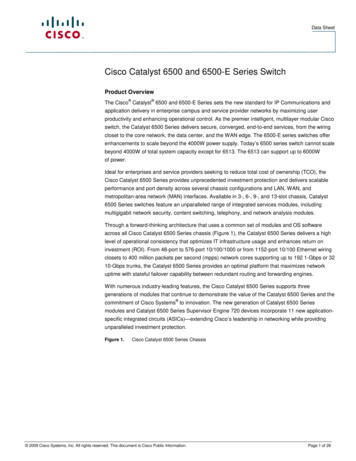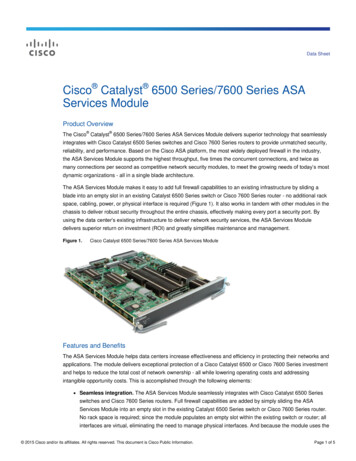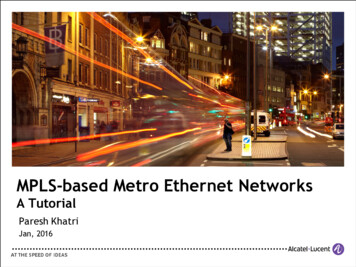
Transcription
Data SheetCisco ME 6500 Series Ethernet Switch The Cisco ME 6500 Series Ethernet Switch is a next-generation, fixed-configurationswitch built around the requirements of next-generation Carrier Ethernet networks. Based on ground-breaking Cisco Catalyst 6500 technology, the Cisco ME 6500 Series costeffectively delivers on the stringent performance, reliability, and QoS requirements oftriple-play services, as well as VPN services for Ethernet-to-the-Home (ETTH), Ethernetto-the-Business (ETTB), and DSLAM Aggregation deployments in a space- and poweroptimized 1.5-rack unit package. The Cisco ME 6500 Series completes the Cisco CarrierEthernet solution portfolio by extending the most advanced MPLS, QoS, multicast, andIPv6 features into Ethernet access and aggregation networks, enabling scalable andservice-rich Gigabit Ethernet access for both fiber and copper deployments.Product OverviewThe Cisco ME 6500 Series Ethernet Switch is a high-performance, fully featured, and resilientEthernet switch. Equipped standard with the Policy Feature Card 3C (PFC3C) and MultilayerSwitch Feature Card 2A (MSFC2A), the Cisco ME 6500 Series facilitates the delivery of profitableMetro Ethernet and triple-play services by providing capabilities suitable for service providers’Carrier Ethernet access and broadband aggregation networks.The Cisco ME 6524 Ethernet Switch is the first available product of the Cisco ME 6500 Series.The Cisco ME 6524 is available in two configurations: 24 Gigabit Ethernet Small Form-Factor Pluggable (SFP) downlinks and 8 Gigabit EthernetSFP uplinks, with redundant DC power supplies (Figure 1).Figure 1. Cisco ME 6524 with 24 Gigabit Ethernet SFP Downlinks24 Ethernet 10/100/1000 downlinks and 8 Gigabit Ethernet SFP uplinks, with redundant DCpower supplies (Figure 2).Figure 2.Cisco ME 6524 with 24 Ethernet 10/100/1000 DownlinksAll contents are Copyright 1992–2007 Cisco Systems, Inc. All rights reserved. This document is Cisco Public Information.Page 1 of 14
Data SheetThe Cisco ME 6524 Ethernet Switch is shipped with the IP Base Software image. The imageincludes the Layer 2 feature set, RIP, and EIGRP stub.For greater service breadth and network flexibility, the Cisco ME 6524 Ethernet Switch offers the IPServices license that provides IPv4 feature set, and the Advanced IP Services Software licensethat provides Multiprotocol Label Switching (MPLS) and IPv6 functionality.The Cisco ME 6524 offers: Optimal Gigabit Ethernet density: With up to 32 Gigabit Ethernet ports, all fiber-based, theCisco ME 6524 can aggregate fiber-to-the-x (FTTx) customers who require Gigabit Ethernetconnectivity. The uplink interfaces offer flexible connectivity options by accommodating abroad range of SFP optics, including coarse wavelength-division multiplexing (CWDM) anddense wavelength-division multiplexing (DWDM) optics. Flexible Metro Ethernet deployment options: The switch features highly scalable Layer 2services with features such as intelligent 802.1Q tunneling, Layer 2 Protocol Tunneling, andVLAN Translation. The PFC3C daughter card enables in-hardware MPLS technologies forMPLS VPNs, Ethernet over MPLS (EoMPLS), and Hierarchical Virtual Private LAN Services(H-VPLSs). For service providers facing an increasing demand for IP address space,hardware-enabled IPv6 protocols provide a scalable and high-performing end-to-end IPservice delivery. Flexible Metro Ethernet deployment options: The switch features highly scalable Layer 2services with features such as intelligent 802.1Q tunneling, Layer 2 Protocol Tunneling, andVLAN Translation. The PFC3C daughter card enables in hardware MPLS technologies forMPLS VPNs, Ethernet over MPLS (EoMPLS), and Hierarchical Virtual Private LAN Services(H-VPLS). For service providers facing an increasing demand for IP address space,hardware-enabled IPv6 protocols provide a scalable and high-performing end-to-end IPservice delivery. Optimal performance and scalability: The ME 6524 offers high performance CPU for Layer2 and Layer 3 protocols convergence and stability. The switch features scalable Layer 2switching, IP routing and MPLS functionalities in hardware without performance impact. Increased service availability: The Cisco ME 6524 helps ensure service and network uptime with its support of Cisco EtherChannel protocols, rapid convergence protocols such asIEEE 802.1w/802.1s and Flexlink, and gateway load-balancing protocols. The support forsoftware modularity delivers several new benefits. By enabling modular Cisco IOSsubsystems to run as independent, self-healing processes, this innovation reducesunplanned downtime through fault containment and stateful process restarts, simplifiessoftware changes through subsystem In-Service Software Upgrades (ISSU), and enablesprocess-level, automated policy control by integrating Embedded Event Manager (EEM), allkey benefits necessary for Carrier Ethernet and broadband aggregation deployments. Tohelp minimize service outage due to a power supply failure, the Cisco ME 6524 can beconfigured with redundant DC power supplies that are field-replaceable and hot-swappable. Integrated security: The Cisco ME 6524 offers a comprehensive set of security features tomitigate denial-of-service (DoS) attacks, to restrict the access to the service-providernetwork, and to safeguard subscribers’ and network resources. Port-based and VLANbased access control lists (ACLs) restrict the unwanted traffic based on traffic and users;CPU rate limiters and control plane policing (CoPP) limit the amount of traffic that entersthe network; Port Security limits the number of MAC addresses that can be learned; DHCPAll contents are Copyright 1992–2007 Cisco Systems, Inc. All rights reserved. This document is Cisco Public Information.Page 2 of 14
Data SheetSnooping, dynamic ARP inspection, and IP Source Guard prevent threats from the DHCPserver, default gateways, or address spoofing attacks. These integrated security featuresare hardware-enabled so they can be enabled concurrently without jeopardizing the systemperformance as the traffic level increases.ApplicationsThe Cisco ME 6524 helps enable Carrier Ethernet service providers to offer hardware-acceleratedVPN services for ETTB, ETTH, and DSLAM aggregation deployments.Triple-Play ServicesBy using the same network infrastructure to offer data, voice, and video, service providers canreduce their operating expenses (OpEx) while increasing their revenue sources.Key service enablers for triple-play delivery on the Cisco ME 6524 are multicast protocols forintelligent video distribution, security features to isolate subscriber traffic streams and to protectagainst malicious user attacks, and QoS features to concurrently support multiple classes ofservice and prioritize traffic that is sensitive to drops, delays, and jitter.The Cisco ME 6524 is designed to enable triple-play services with either DSL or Ethernet in thefirst mile, and with an underlying architecture based on Layer 2, IPv4, IPv6, or MPLS. See Figure3.Figure 3.Cisco ME 6524 Delivers Triple-Play ServicesAll contents are Copyright 1992–2007 Cisco Systems, Inc. All rights reserved. This document is Cisco Public Information.Page 3 of 14
Data SheetLayer 2 and Layer 3 VPNsLayer 2 and Layer 3 VPNs have been widely deployed by service providers since the beginning ofMetro Ethernet service adoption. VPNs are well suited for ETTB/FTTB applications such asinterbranch connectivity, Internet access, intranets, and extranets.Layer 2 VPNs can be delivered over a pure Layer 2 infrastructure. By enabling features as 802.1Qtunneling, Layer 2 Protocol Tunneling (L2PT), and VLAN translation, the Cisco ME 6524 allows theCarrier Ethernet service provider to segment and transparently transport the subscribers’ traffic.Alternatively, Layer 2 VPNs can be offered through Ethernet over MPLS. This technology providesa Layer 2 tunneling mechanism over a Layer 3 MPLS network, thus using the Layer 3 networkconvergence protocols without the need for Spanning Tree Protocol.Layer 3 VPNs, often referred to as MPLS VPNs, are multipoint Layer 3 services (see Figure 4).The PFC3C complex on the Cisco ME 6524 enables MPLS in hardware and provides QoS andresiliency capabilities such as MPLS Experimental (MPLS EXP) bit marking, MPLS TrafficEngineering (MPLS TE), and MPLS Fast Reroute (MPLS FRR).Figure 4.Cisco ME 6524 Supports Layer 2 and Layer 3 VPNsH-VPLS ArchitectureH-VPLS is an alternative mechanism to provide Layer 2 VPNs services (see Figure 5). By buildingtwo- or three-tiered hierarchical networks, H-VPLS improves the scalability of multipoint VPLS. HVPLS features two deployment options: MPLS access network: The ME 6524 plays the role of the H-VPLS spoke. Ethernet overMPLS (EoMPLS) tunnels configured on the ME 6524 are terminated in VPLS instances atthe core edge of the network. Layer 2 access network: The Cisco ME 6524 configures VLAN-based services that areterminated in VPLS instances at the core edge of the network.Key features on the Cisco ME 6524 for H-VPLS deployments are EoMPLS VC Type 4 or VC Type5, Traffic Engineering (TE) for Open Shortest Path First (OSPF) and Intermediate System-toIntermediate System (IS-IS), Guaranteed Bandwidth Traffic-Engineered tunnels, and MPLS FRR.All contents are Copyright 1992–2007 Cisco Systems, Inc. All rights reserved. This document is Cisco Public Information.Page 4 of 14
Data SheetFigure 5.Cisco ME 6524 in an H-VPLS ArchitectureKey Features and BenefitsTable 1 describes the features and benefits of the Cisco ME 6524, and Table 2 providesinformation about its scalability.Table 1.Cisco ME 6524 Features and BenefitsFeaturesBenefitsLayer 2 SwitchingIEEE 802.1Q802.1Q TunnelingLayer 2 Protocol Tunneling (L2PT)1:1 VLAN Translation802.1Q and L2PT are the service enablers to offer Layer 2 VPNs. Byencapsulating subscribers’ data frames in a service provider 802.1Qtag and by tunneling subscribers’ PDU, 802.1Q tunneling offersTransparent LAN Services (TLS) to scale the number of MetroEthernet subscribers beyond the 4096 VLAN boundary.VLAN Translation increases the flexibility of single tagged 802.1Qservice by decoupling subscribers’ and service provider’s VLAN IDs.IEEE 802.1DIEEE 802.1wIEEE 802.1sFlexlinkPort Aggregation Protocol (PAgP)IEEE 802.3adProtocols such as IEEE 802.1D, IEEE 802.1w, and IEEE 802.1s helpensure business continuity by minimizing the network convergencetime for time-sensitive applications.Flexlink provides fast failover over point-to-point connections, withoutthe overhead of control protocols.PAgP and IEEE 802.3ad increase bandwidth availability and providefast link failover within the Cisco EtherChannel bundle.Unidirectional Link DetectionUnidirectional Link Detection (UDLD) increases the network reliabilityby quickly detecting unidirectional links or misplaced fiber connectors.Cisco Discovery ProtocolCisco Discovery Protocol and VTP ease the network and serviceconfiguration by detecting peer capability and by propagating theVLANs information within the service-provider network.VLAN Trunk Protocol (VTP)Layer 3 RoutingOpen Shortest Path First (OSPF)Enhanced Interior Gateway Routing Protocol(EIGRP)High-performance IP routing protocols form the foundation for scalableLayer 3 services.Intermediate System-to-Intermediate System (ISIS) ProtocolBorder Gateway Protocol Version 4 (BGPv4)Hot Standby Router Protocol (HSRP)Virtual Router Redundancy Protocol (VRRP)Gateway Load Balancing Protocol (GLBP)Bidirectional Forwarding Detection (BFD) forOSPF, IS-IS and BGPStatic RoutingOSPF Graceful Restart (RFC 3623)All contents are Copyright 1992–2007 Cisco Systems, Inc. All rights reserved. This document is Cisco Public Information.Page 5 of 14
Data SheetFeaturesBenefitsEfficient Multicast DistributionProtocol Independent Multicast (PIM, PIM-SM,PIM-SSM)PIM SnoopingEnable efficient and scalable delivery of video applications. Theintelligent multicast replication allows scaling the triple-play offering tomultiple DSL or FTTx subscribers.Bidirectional PIMInternet Group Management Protocol version 1, 2,3 (IGMP v1, v2, v3)IGMP SnoopingTriggered PIM joinsAdvanced Quality of ServiceIngress Policing – Per Port, Per VLAN, Per Port Per VLANPer-port egress policingDSCP TransparencyFlexible Policing functions classify and rate-limit the subscribers’ trafficbased on port, VLAN, and port VLAN information. Layer 3 per-portegress policing allows the delivery of multipoint services with tightservice-level agreement (SLA) requirements. Customer traffic can bemarked at Layer 2 or Layer 3, to fulfill differentiated QoS models.Class of service (CoS) MutationPriority QueueShaped Round Robin (SRR)Deficit Weighted Round Robin (DWRR)Weighted Random Early Detection (WRED)Intelligent queuing mechanism helps ensure that the highest-prioritydata is serviced ahead of other traffic.Congestion avoidance and scheduling algorithms help regulate trafficand prevent network congestion. SRR enhances the schedulingalgorithm by shaping the traffic that egress each queue.Robust Security SolutionPrivate VLANIEEE 802.1xDynamic Host Configuration Protocol (DHCP)SnoopingDHCP Option 82Dynamic ARP InspectionIP Source Guard and Private HostVLAN-based and port-based ACLsPort Security on Access, 802.1Q trunk, and802.1Q tunneling portsPer-VLAN MAC LimitingControl Plane PolicingHardware-based Rate LimitersStorm ControlPrivate VLAN and Private Host enforce subscribers’ security byisolating the traffic flows coming from different users.IEEE 802.1x, port-based security and port-based access lists allow togrant access to network resources and privileges through identitybased networking.DHCP Snooping, DHCP Option 82, Dynamic ARP Inspection, and IPSource Guard help in identifying user’s MAC and IP address and portnumber, hence preventing attacks from malicious users.Malicious attacks can jeopardize the functionality of the serviceprovider network by compromising the switch CPU, MAC table, etc.Features such as Port Security and Per-VLAN MAC Limiting restrict thenumber of MAC addresses that can be learned on the service-providernetwork.Hardware-enabled ACLs and rate limiters restrict undesired traffic inthe network, while storm control features rate-limit the amount ofbroadcast and multicast frames injected into the switch.Unicast Flood BlockingMPLSEthernet over MPLS (EoMPLS)EoMPLS VC Type 4 and VC Type 5MPLS VPN (RFC2547)MPLS Traffic Engineering (MPLS TE)Enhance the service flexibility by allowing Layer 2 and Layer 3 servicesintegration on the same platform.MPLS TE and FRR features allow to transport services with differentlevels of protection and service guarantees.MPLS Traffic Engineering (MPLS TE) Class-BasedTunnel SelectionMPLS Fast Reroute (MPLS FRR)MPLS Fast Reroute (MPLS FRR) PrefixIndependenceMPLS Graceful RestartIPv6Native IPv6RIPng, MP-BGP4, OSPFv3IPv6 over IPv4 TunnelsInternet Control Message Protocol version 6(ICMPv6)Improve the scalability of IP deployments, allowing high performingnetwork evolution.Multicast protocols and QoS features optimize triple-play and videodelivery over an end-to-end IP architecture.Configured, Automatic, GRE, 6to4, ISATAPTunnelsIPv6 QoSPIM-SM and PIM-SSMAll contents are Copyright 1992–2007 Cisco Systems, Inc. All rights reserved. This document is Cisco Public Information.Page 6 of 14
Data SheetTable 2.Cisco ME 6524 Scalability NumbersDescriptionSpecificationMAC AddressesUp to 96,000IPv4 RoutesUp to 256,000IPv6 RoutesUp to 128,000EoMPLS Tunnels4096MPLS VPNs512NetFlow EntriesUp to 128,000Product ArchitectureTable 3 lists details about the Cisco ME 6524 product architecture. Table 4 and Table 5 list productspecifications and standards and management information. Table 6 provides safety andcompliance information.Table 3.Cisco ME 6524 Product ArchitectureDescriptionSpecificationHardware-Based Forwarding EnginePolicy Feature Card 3C (PFC3C) onboardMSFC Daughter Card VersionMSFC2A onboardPerformanceUp to 15 mppsSwitching Capacity32 GbpsUplinks8 Gigabit Ethernet SFP interfaces 24 Gigabit Ethernet SFP interfacesor 24 Ethernet 10/100/1000 interfacesDownlinksMTU9216 bytes – Jumbo frames supported on uplink and downlink interfacesUplink OversubscriptionNot over-subscribedDownlink Oversubscription3:1 in case of 1 GE port speed TX: 1p3q8t RX: 2q8tUplink Queue Structure Deep Buffer: 12.8 MB per port (50% TX and 50% RX)Uplink Port SchedulerStrict Priority Scheduling with either Shaped Round Robin (SRR) or DeficitWeighted Round Robin (DWRR) TX: 1p3q8t RX: 1q2tDownlink Queue Structure Deep Buffer TX: 21.33 MB per port Deep Buffer RX: 240 KB shared by three portsDownlink Port SchedulerDWRR, Weighted Random Early Detection (WRED)USB PortTwo USB ports (host and device)Product SpecificationsTable 4.Product SpecificationsDescriptionSpecificationSoftware compatibilityCisco IOS Software Release 12.2(18)ZUProtocolsLayer 2 switching protocols Layer 3 routing protocolsMulticast protocolsComprehensive MPLS supportIPv6All contents are Copyright 1992–2007 Cisco Systems, Inc. All rights reserved. This document is Cisco Public Information.Page 7 of 14
Data SheetDescriptionSpecificationUSB PortTwo USB ports (host and device)Connectors and CablingManagement Console Port: RS232 (RJ-45) 100FX-GE 100FX-FE 100LX-FE 100EX-FE 100ZX-FE 1000BASE-BX10-U 1000BASE-BX10-D 1000BX-10-U 1000BX-10-D 1000BASE-SX 1000BASE-LH 1000BASE-LX 1000BASE-ZX 1000BASE-TCWDM SFPsDWDM SFPs supported are: DWDM-SFP-30.33 DWDM-SFP-31.12 DWDM-SFP-31.90 DWDM-SFP-32.68 DWDM-SFP-34.25 DWDM-SFP-36.61 DWDM-SFP-38.19 DWDM-SFP-40.56 DWDM-SFP-42.94 DWDM-SFP-44.53 DWDM-SFP-46.12 DWDM-SFP-46.92 DWDM-SFP-47.72 DWDM-SFP-48.51 DWDM-SFP-50.12 DWDM-SFP-50.92 DWDM-SFP-51.72 DWDM-SFP-54.13 DWDM-SFP-54.94 DWDM-SFP-56.55 DWDM-SFP-58.98 DWDM-SFP-59.79 DWDM-SFP-60.61Support for the remaining DWDM wavelengths is targeted for the second half of 2007.Memory256 MB of default DRAM for the switch processor, upgradeable to 512 MB or 1 GB512 MB of default DRAM for the router processor, upgradeable to 1 GB128-MB boot flash for the switch processor64-MB boot flash for the route processorOptionsRemovable storage: 512 MB and 1 GB(compact flash)All contents are Copyright 1992–2007 Cisco Systems, Inc. All rights reserved. This document is Cisco Public Information.Page 8 of 14
Data SheetDescriptionSpecificationReliability and AvailabilityDual field-replaceable and hot-swappable redundant DC power suppliesField-replaceable and hot-swappable fan unitMean Time Between Failure (MTBF) includes two DC power supplies: 58481 hours for ME-C6524GS-8S 59172 hours for ME-C6524GT-8SMean Time Between Critical Failure (MTBCF): 69155 hours for ME-C6524GS-8S 70983 hours for ME-C6524GT-8SMean Time Between Failure (MTBF) for single DC power supply: 497394 hoursMean Time Between Failure (MTBF) for the fan tray: 775008 hoursPhysical Dimensions(H x W x D)1.5 RUWeight29.13 lb (13.21 Kg)PowerMaximum Output Power: 400W2.625 x 17.45 x 19 in. (6.7 x 44.3 x 48.3 cm)Maximum Input Power consumption: 533WDC input voltage: Domestic, –40.5 VDC to –56 VDC continuous International, –55 VDC to –72 VDC continuousDC input current: 11A @ –48 VDC 9A @ –60 VDCAll contents are Copyright 1992–2007 Cisco Systems, Inc. All rights reserved. This document is Cisco Public Information.Page 9 of 14
Data SheetStandards and ManagementTable 5.Cisco ME 6524 Standards and ManagementDescriptionStandards and ProtocolsSpecification IEEE 802.3 IEEE 802.3u IEEE 802.3z IEEE 802.3x IEEE 802.3ab IEEE 802.1t IEEE 802.1u IEEE 802.1Q IEEE 802.1p IEEE 802.1D IEEE 802.1w IEEE 802.1s IEEE 802.1x IEEE 802.3ad IEEE 802.1ag IEEE 802.3ah IEEE 802.3x RIPv2 EIGRP OSPF OSPF Graceful Restart (RFC 3623) IS-IS BGPv4 Policy Based Routing (PBR) HSRP (RFC2281) Virtual Router Redundancy Protocol (VRRP) Bidirectional Forwarding Detection (BFD) for OSPF and IS-IS Internet Group Management Protocol (IGMP) v1, v2, v3 IGMP Proxy reporting for IGMPv2 and MLDv1 PIM PIM-SM, PIM-SSM, Bidirectional PIM WCCPv2 MPLS VPN (RFC2547) Ethernet over MPLS (EoMPLS Martini draft) Generic Routing Encapsulation (GRE)Management Simple Network Management Protocol Version 1, 2, and 3 (SNMPv1, v2, v3) Telnet Interface VTP CDP IGMP Snooping DHCP Snooping Remote Switch Port Analyzer (RSPAN), Encapsulated Remote SPAN(ERSPAN) Embedded Remote Monitoring (RMON) software agent Domain Name System (DNS) Trivial File Transfer Protocol (TFTP) Network Timing Protocol (NTP) Embedded Event Manager (EEM) Multifunctional LEDs per port, and multifunction LEDs for power suppliesAll contents are Copyright 1992–2007 Cisco Systems, Inc. All rights reserved. This document is Cisco Public Information.Page 10 of 14
Data SheetDescriptionMIBsSpecification BRIDGE-MIB (RFC1493) BGP4-MIB (RFC1657) CISCO-ACCESS-ENVMON-MIB CISCO-BGP-POLICY-ACCOUNTING-MIB CISCO-BGP4-MIB CISCO-CDP-MIB CISCO-CLASS-BASED-QOS-MIB CISCO-CONFIG-COPY-MIB CISCO-CONFIG-MAN-MIB CISCO-ENTITY-ALARM-MIB CISCO-ENTITY-EXT-MIB CISCO-ENTITY-VENDORTYPE-OID-MIB CISCO-FLEX-LINKS-MIB CISCO-FTP-CLIENT-MIB CISCO-HSRP-EXT-MIB CISCO-HSRP-MIB CISCO-IETF-IP-FORWARD-MIB CISCO-IETF-IP-MIB CISCO-IF-EXTENSION-MIB CISCO-IMAGE-MIB CISCO-IP-STAT-MIB CISCO-IPMROUTE-MIB CISCO-L2-CONTROL-MIB CISCO-L2-TUNNEL-CONFIG-MIB CISCO-MAC-NOTIFICATION-MIB CISCO-MEMORY-POOL-MIB CISCO-NDE-MIB CISCO-OSPF-MIB CISCO-OSPF-TRAP-MIB CISCO-PAE-MIB CISCO-PAGP-MIB CISCO-PIM-MIB CISCO-PING-MIB CISCO-PRIVATE-VLAN-MIB CISCO-PROCESS-MIB CISCO-PRODUCTS-MIB CISCO-QUEUE-MIB CISCO-RMON-CONFIG-MIB CISCO-RTTMON-MIB CISCO-STP-EXTENSIONS-MIB CISCO-SVI-AUTOSTATE-MIB CISCO-SWITCH-ENGINE-MIB CISCO-SYSLOG-MIB CISCO-TCP-MIB CISCO-UDLDP-MIB CISCO-VLAN-IFTABLE-RELATIONSHIP-MIB CISCO-VLAN-TRANSLATION-MIB CISCO-VTP-MIB ENTITY-MIB ENTITY-SENSOR-MIB EVENT-MIB IF-MIB IGMP-MIB IPMROUTE-MIB MPLS-LDP-MIB MPLS-LSR-MIB MPLS-TE-MIB MPLS-VPN-MIB NOTIFICATION-LOG-MIBAll contents are Copyright 1992–2007 Cisco Systems, Inc. All rights reserved. This document is Cisco Public Information.Page 11 of 14
Data SheetDescriptionSpecification OLD-CISCO-CHASSIS-MIB OLD-CISCO-CPU-MIB OLD-CISCO-INTERFACES-MIB OLD-CISCO-IP-MIB OLD-CISCO-MEMORY-MIB OLD-CISCO-TCP-MIB OSPF-MIB OSPF-TRAP-MIB PIM-MIB PWE-MIB RFC1213-MIB RMON-MIB RMON2-Mib RSVP-MIB SMON-MIB SNMP-FRAMEWORK-MIB SNMP-NOTIFICATION-MIB SNMP-PROXY-MIB SNMP-TARGET-MIB SNMP-USM-MIB SNMP-VACM-MIB SNMPv2-MIB SOURCE-ROUTING-MIB TCP-MIB UDP-MIBMetro Ethernet ForumMEF9 and MEF14 certifiedSafety and ComplianceTable 6.Safety and ComplianceDescriptionElectromagnetic Emission Compliance(EMC)Specification CE marking FCC Part 15 VCCI Class A EN55022 Class A CISPR 22 Class A AS/NZS CISPR22 Class A ETS300 386 EN55024 EN61000-3-2 EN61000-3-3 EN 50121-1 EN 50121-4Safety UL 60950 CSA-C22.2 No. 60950 EN 60950 IEC 60950NEBS GR-63-CORE NEBS Level 3 GR-1089-CORE NEBS Level 3ETSI ETS 300 019 Storage Class 1.1 ETS 300 019 Transportation Class 2.3 ETS 300 019 Stationary Use Class 3.1Noise Specifications Central Office (CO) Specification: 60 dBAAll contents are Copyright 1992–2007 Cisco Systems, Inc. All rights reserved. This document is Cisco Public Information.Page 12 of 14
Data SheetDescriptionSpecification Temperature: 32 F (0 C) to 104 F ( 40 C) Altitude: Up to 10,000 ft (3000m)Operating Environment Relative humidity: 10% to 85% (noncondensing) Temperature: –4 F (–20 C) to 149 F ( 65 C) Altitude: 15,000 ft (4570m)Storage Environment Relative humidity: 5% to 95% (noncondensing)Ordering InformationTable 7 lists the ordering information for Cisco ME 6524.To place an order, visit the Cisco Ordering Home Page.Table 7.Ordering InformationPart NumberDescriptionME-C6524GS-8S24 Gigabit Ethernet SFP interfaces 8 Gigabit Ethernet SFP uplinks, 1 Fan TrayME-C6524GT-8S24 Ethernet 10/100/1000 interfaces 8 Gigabit Ethernet SFP uplinks, 1 Fan TrayPWR-400W-DC400W DC Power Supply for the Cisco ME 6524MEM-XCEF720-256MDefault Memory on the Cisco ME 6524 Switch ProcessorMEM-XCEF720-512M512-MB Memory Upgrade Option for the Switch Processor on the Cisco ME 6524MEM-XCEF720-1GB1-GB Memory Upgrade Option for the Switch Processor on the Cisco ME 6524MEM-MSFC2-512MBDefault Memory on the Cisco ME 6524 Router ProcessorMEM-MSFC3-1GB1-GB Memory Upgrade Option for the Router Processor on the Cisco ME 6524MEM-C6K-CPTFL512MDefault External Compact Flash memory 512 MBS523IBL-12233SXHCisco ME 6524 IOS IP BASE LAN onlyS523IBK9L-12233SXHCisco ME 6524 IOS IP BASE SSH LAN onlyS523AIK9L-12233SXHCisco IOS Advanced IP ServicesService and Support Cisco Systems offers a wide range of services programs to accelerate customer success. Theseinnovative services programs are delivered through a unique combination of people, processes,tools, and partners, resulting in high levels of customer satisfaction. Cisco services help you toprotect your network investment, optimize network operations, and prepare the network for newapplications to extend network intelligence and the power of your business. For more informationabout Cisco services, see Cisco Technical Support Services or Cisco Advanced Services.For More InformationFor more information about the Cisco ME 6524, dex.html or contact your local accountrepresentative.All contents are Copyright 1992–2007 Cisco Systems, Inc. All rights reserved. This document is Cisco Public Information.Page 13 of 14
Data SheetPrinted in USAAll contents are Copyright 1992–2007 Cisco Systems, Inc. All rights reserved. This document is Cisco Public Information.C78-328339-02 08/07Page 14 of 14
Ethernet switch. Equipped standard with the Policy Feature Card 3C (PFC3C) and Multilayer Switch Feature Card 2A (MSFC2A), the Cisco ME 6500 Series facilitates the delivery of profitable Metro Ethernet and triple-play services by providing capabilities suitable for service providers' Carrier Ethernet access and broadband aggregation networks.

